Wow, what a fun event. Christine D’Abrosca England, beverage manager at Malo did a great job putting the event together, and everyone had a blast. We also got to sample a great many very tasty cocktails.
Alas, my pictures were wretched, for a number of reasons, not the least of which was the fact that I was more preoccupied with cocktail judging than I was with photography, plus my camera performs very poorly in low-light situations. (That’s on the agenda for this year — a Nikon D90 with a professional-quality flash.) For better photography of the event, check out the shots from Stephen Cheng, the event’s official photographer.
The coolest aspect of the event was the half that featured female mixologists (look out, gentlemen!), all of whom made delectable concoctions that also featured the common base spirit to the event, Gran Centenario’s port-barrel-rested, hibiscus-infused reposado tequila Rosangel. The non-competing featured mixologists were Natalie Bovis, “The Liquid Muse”, Kylee Van Dillen of The Westside Tavern, Tina Brandelli (who used to work at Alembic in San Francisco, but somehow I managed to not find out where she’s working here) and “Liquid Chef” Kim Haasarud (whom I’ve known by reputation for years and whose husband I worked with for years, but whom I only managed to meet for the first time at the event!) who among many other places is arranging the cocktail program for Downtown’s forthcomign Bottega Louie. My good friend Marleigh Riggins was scheduled but wasn’t able to make it due to a bad back (d’oh!), but here’s the cocktail she would have served, with two posts on its creation:
The Mojave Fix
(Created by Marleigh Riggins)
2 ounces Gran Centenario Rosangel Tequila.
1/2 ounce Oloroso sherry.
1 ounce piloncillo-hibiscus-chipotle syrup (recipe below).
1 ounce fresh lemon juice.
1/2 ounce soda water.
Orange flower water.
Shake tequila, sherry, syrup and lemon juice over ice. Strain into a double old-fashioned glass filled with crushed ice and top with soda. Sprinkle a few drops of orange flower water over the top and garnish with a lemon blossom.
Piloncillo-Hibiscus-Chipotle Syrup
1 cone piloncillo.
3/4 cup dried hibiscus flowers.
5 small-medium dried chipotle chiles (not in adobo).
2 cups water.
Bring water and piloncillo to a boil in a medium saucepan. Simmer until piloncillo is fully dissolved, remove from heat and add hibiscus and chiles. Let syrup steep for at least two hours, up to overnight. Strain through cheesecloth into a jar and refrigerate.
I was thinking about a piloncillo syrup when I first got ahold of this, but not an infused one! Yummers — I expect to have one of these made for me soon, Marleigh!
(I did actually make a plain piloncillo syrup, and I found that the best way to get it to dissolve easily is to place the piloncillo cone into a heavy freezer-type ziploc bag, then place that bag into another bag, then pound the crap out of it with a hammer until it’s powder. Otherwise prepare to wait an hour and a half for that big hard cone of sugar to dissolve.)
I managed to snag a couple of the other recipes, although I was seriously bummed not to have gotten any of this one — Natalie’s shift behind the stick was when I was tasting the competitors’ creations, and I missed it completely, d’oh. Here’s hoping Natalie saved me a little of her homemade ingredient too, ’cause this drink looked lovely.
Flor de Maria
(Created by Natalie Bovis)
1-1/2 ounces Gran Centenario Rosangel Tequila.
1/2 ounce homemade hibiscus cabernet syrup (hibiscus tea syrup with a cabernet reduction).
1/4 ounce Luxardo Maraschino liqueur.
3/4 ounce fresh lemon juice.
Spritz of orange flower water (load into mister).
1 – 2″ piece of orange peel.
Lemon peel for garnish.
Muddle orange peel in the bottom of a mixing glass. Add maraschino liqueur, syrup, lemon juice and tequila. Shake with ice for 10-12 seconds. Strain into a cocktail glass. Spritz with orange flower water. Garnish with a sliver of lemon zest.
I did get to try Kylee’s, and it was delicious; besides the base spirit she uses one of my favorite ingredients these days. Go see her at the Westside Tavern if you’re local.
Per Gazardiel
(Created by Kylee Van Dillen, Westside Tavern, Los Angeles)
2 ounces Gran Centenario Rosangel tequila.
3/4 ounce Aperol.
3/4 ounce grapefruit juice.
3/4 ounce simple syrup.
1/2 ounce fresh lime juice.
2-3 basil leaves, torn.
Muddle the basil with the spirit ingredients, add juices and syrup and shake with ice for 10-12 seconds. Double-strain into a cocktail glass, and garnish with a whole basil leaf.
Now, onto the competition! The competitors were Juan Alvarez, bartender at J. King Neptune’s in Sunset Beach and current president of the Los Angeles chapter of the United States Bartenders’ Guild; Mark Blackhart, not a professional bartender but an enthusiast who writes about his cocktail nerdiness at Drink Well; Jason Bran of The Roger Room; Matty Eggleston [formerly] of The Varnish and The Hungry Cat; and finally Silamith Weir, who doesn’t currently work behind the stick but [until recently was] the local brand represntative for the fabulous Martin Miller’s Gin.
Besides myself the judges were ace bartender Marcos Tello (or, to be specific, his alter-ego Marcela) of The Varnish and The Edison The Tar Pit, and pastry chef Cat Schimenti, [formerly] of Craft Los Angeles (and ’09 James Beard Award nominee!). This was my second competition as a judge, and another wonderful learning experience. Working on this with Cat was a particular pleasure, to get the perspective of someone who’s highly trained and has great expertise in flavor but isn’t a bartender. Her approach as a pastry chef was fascinating during our deliberations.
Without further ado, the winner of the judges’ choice award … *drum roll* … Matty Eggleston for his creation called The Lullaby. Before tasting I took one look at the recipe card on Matty’s table and said, “Oh man … tequila and Nutella?! Huevos of steel!” Seriously, Matty is one of the most creative and inventive bartenders I know, and really thinks outside the box when it comes to flavors, both sweet and savory (and even meaty!). As skeptical as one might have been when presented with these ingredients, they combined beautifully in a three-ingredient cocktail in which the preparation belied the simplicity of the ingredients. The tequila flavor was prominent, with the fruitiness of the Rosangel complementing the nutella which, when smoothed out by the steamed milk and accented by the cinnamon garnish made you think of Mexican chocolate. Creative and daring and delicious.
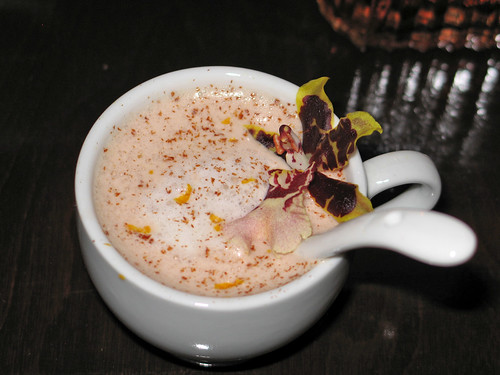
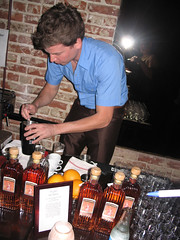
The Lullaby
(Created by Matty Eggleston)
4 ounces Gran Centenario Rosangel Tequila.
3 tablespoons Nutella.
1/2 cup whole milk.
In a frothing tin, steam 1/2 cup whole milk and Nutella. Steam until warm and agitate with bar spoon. Add the tequila and steam a moment more. Pour into four tea cups or larger espresso cups. Garnish with a light dusting of freshly grated cinnamon and orange zest.
I need to double-check the milk amount with Matty — the recipe card was a bit confusing with the way it was printed. It’s either 1/2 or 1 cup.
Now for the people’s choice winner … the creamy, tangy entry from Silamith Weir.
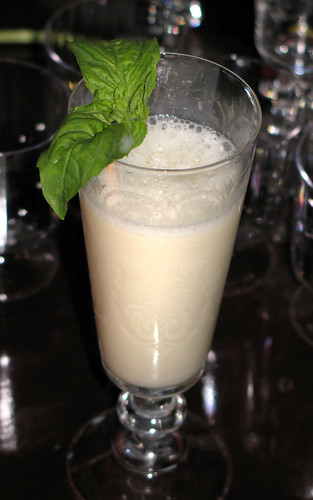
Casa Blanco
(Created by Silamith Weir)
2 ounces Gran Centenario Rosangel.
1/2 ounce Matusalem Gran Reserva.
3 chunks of pineapple.
4-5 basil leaves (shredded).
3/4 ounce fresh lime juice.
1/2 ounce sweetened condensed milk.
1/2 ounce simple syrup.
Muddle pineapple and basil together. Add all other ingredients and shake vigorously. Strain into cocktail glass.
If you have a Latino market near you, Nestle’s La Lechera brand of sweetened condensed milk now comes in handy resealable squeeze bottles, making it perfect for mixing this drink … as well as drizzling on fruit, sno-balls or, um, directly into your mouth. (Okay, into a spoon and then into your mouth.)
Congratulations to the winners and to all the mixologists who participated!

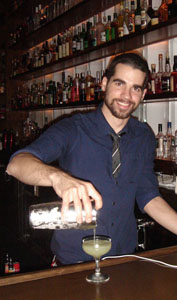
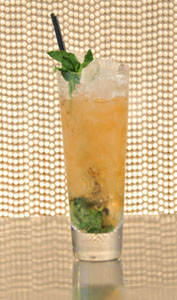

 Among the many wonderful things I’ve learned about from my friend Ted Haigh, there was at least one horrible one, or so I thought at first. Malört is a Swedish-style bitter liqueur (although I’d hesitate to call it an amaro, as it’s very different from Italian liqueurs described as such) based on wormwood; “malört is actually Swedish for wormwood. Unlike absinthe it has no anise flavoring components, or any other spread of botanicals as far as I can tell — this stuff’s pure, whap-you-in-the-face-with-a-large-tree-branch wormwood with all its concomitant bitterness. It is, quite probably, the most bitter thing you will ever pour out of a bottle and into your mouth that’s considered potable and non-poisonous.
Among the many wonderful things I’ve learned about from my friend Ted Haigh, there was at least one horrible one, or so I thought at first. Malört is a Swedish-style bitter liqueur (although I’d hesitate to call it an amaro, as it’s very different from Italian liqueurs described as such) based on wormwood; “malört is actually Swedish for wormwood. Unlike absinthe it has no anise flavoring components, or any other spread of botanicals as far as I can tell — this stuff’s pure, whap-you-in-the-face-with-a-large-tree-branch wormwood with all its concomitant bitterness. It is, quite probably, the most bitter thing you will ever pour out of a bottle and into your mouth that’s considered potable and non-poisonous.






